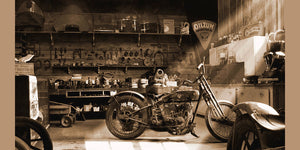Find Competitive Rates on Motocross Parts NZ for Every Bike
Find Competitive Rates on Motocross Parts NZ for Every Bike
Blog Article
Understanding the Necessary Components of a Bike: A Comprehensive Guide for Fanatics
For motorcycle lovers looking to elevate their riding experience and ensure their bikes run efficiently, understanding the crucial parts of a bike is critical. Each component, from the engine's intricate operations to the critical duty of the braking devices, not only affects efficiency but also safety and security and comfort. This overview will go through the basic components that every motorcyclist ought to be familiar with, allowing notified choices in both maintenance and possible upgrades. As we start this expedition, one must ask: how does each element connect to produce the smooth trip every lover looks for?
Engine Components

The camshaft plays a vital role in controlling the timing of the engine's valves, making sure the specific opening and closing required for effective fuel and air intake, along with exhaust expulsion. This timing is important to maintaining optimum engine efficiency and effectiveness. Furthermore, the carburetor or fuel shot system, depending on the motorcycle design, is accountable for mixing air with fuel in the right proportion for burning.
The air conditioning system, either air or liquid-based, functions to keep the engine's temperature level within operational restrictions, preventing getting too hot and guaranteeing durability - mx gear nz. Each part, diligently designed and integrated, adds to the smooth procedure of the engine, specifying the motorbike's power result and overall performance
Transmission System
Integral to the bike's capability, the transmission system makes sure efficient power transfer from the engine to the wheels. This system makes up a number of important parts, consisting of the clutch, transmission, and final drive, each playing a vital duty in equating the engine's power into activity. The clutch, commonly run by a hand bar, offers to disengage the engine and engage from the transmission, permitting smooth equipment changes and regulated velocity.
The transmission, usually referred to as the transmission proper, consists of a set of gears that motorcyclists can manually change via to readjust the bike's speed and torque result. These gears are arranged in a series that makes it possible for the bike to accelerate smoothly and maintain optimal engine performance across different speeds. The majority of motorcycles use a sequential gearbox, requiring the motorcyclist to shift gears in a predetermined order.
Braking Mechanisms
While recognizing the transmission system is crucial to utilizing a motorbike's power, equally crucial is the capability to manage and quit that power properly, which is where stopping systems come right into play. Brakes are important helmet intercom headset for safety and security and efficiency, providing the biker with the essential control to browse numerous terrains and conditions. Typically, bikes feature 2 types of stopping systems: disc brakes and drum brakes.
Disc brakes are extra common in contemporary motorbikes because of their remarkable performance. They contain a brake disc, caliper, and pads. When turned on, the caliper squeezes the brake pads versus the spinning disc, converting kinetic energy into heat, thus slowing down the wheel. This system provides much better warmth dissipation, consistent efficiency, and improved quiting power, especially in wet problems.
Alternatively, drum brakes, though much less common, are still discovered in some bikes. They work by pressing brake shoes versus the internal surface area of a drum connected to the wheel. While usually less efficient in warm dissipation and quiting power, drum brakes Your Domain Name are less complex and a lot more economical.
Understanding these stopping systems' subtleties enables riders to keep their motorbikes appropriately and appreciate the engineering that ensures effective and safe quiting.
Suspension and Steering
Suspension and guiding systems are vital elements that substantially influence a motorbike's handling and experience convenience. The shock absorber, including forks at the front and shock absorbers at the back, soaks up roadway abnormalities, boosting security and control. Front forks, usually telescopic or inverted, compress and rebound to mitigate influences, while rear shock absorbers keep tire contact with the road, crucial for traction and safety and security.
Steering, centered around the handlebars, links the biker to the bike's directional control. The guiding head bearings guarantee smooth operation, permitting precise maneuverability. Proper positioning and maintenance of these bearings are critical for predictable steering action and lowering cyclist tiredness.
The suspension's adjustability is an additional essential aspect; preload, damping, and rebound setups allow customization to match numerous riding designs and conditions. This adaptability is vital for maximizing performance, whether browsing city roads or dealing with sturdy tracks. Innovations like digital shock absorber provide real-time changes, boosting adventure high quality throughout diverse terrains.

Electric Solutions
After guaranteeing a controlled and smooth trip with reliable suspension and steering systems, attention transforms to the electric systems, a pivotal aspect of modern-day motorbikes. These systems play a critical role not just in starting the engine yet likewise in powering various elements that enhance the functionality and safety of the motorcycle.
At the heart of a motorcycle's electric system is the battery, which shops electric energy needed for starting the engine and powering supporting systems - moto parts nz. The alternator or generator, coupled with the rectifier-regulator, guarantees the battery stays charged while the motorbike is in procedure, converting power into electrical power and preserving voltage degrees
The ignition system, an additional crucial element, is accountable for firing up the air-fuel combination in the engine's cylinders. Modern motorbikes frequently use an electronic ignition system, providing higher efficiency and dependability compared to standard systems.
Illumination systems, including fronts lights, tail lights, and signs, are likewise vital, ensuring presence and security for the rider. Extra electronic parts such as sensors, control systems, and top article presents add to advanced functions like fuel shot administration, anti-lock braking systems (ABDOMINAL), and digital control panels, additionally improving the riding experience.
Conclusion
An extensive understanding of a motorcycle's essential parts, including the engine, transmission system, stopping systems, suspension, steering, and electrical systems, is essential for fanatics intending to optimize safety and security, performance, and convenience. Proficiency of these aspects permits notified decisions pertaining to maintenance and upgrades, eventually improving the riding experience. By integrating this expertise, bikers can ensure their motorbikes operate at peak performance and integrity, thereby making the most of both satisfaction and longevity of their cars.
For motorbike fanatics looking to raise their riding experience and guarantee their bikes run smoothly, understanding the necessary components of a motorbike is vital.Integral to the motorbike's performance, the transmission system makes certain effective power transfer from the engine to the wheels.While comprehending the transmission system is vital to utilizing a motorcycle's power, similarly crucial is the ability to regulate and stop that power successfully, which is where stopping devices come into play. Generally, bikes include two types of braking systems: disc brakes and drum brakes.
An extensive understanding of a motorcycle's essential elements, including the engine, transmission system, braking devices, suspension, steering, and electrical systems, is important for fanatics intending to enhance comfort, efficiency, and safety.
Report this page